Numerical Study on Spatio-Temporal Distribution of Cold Front-Induced Waves along the Southeastern Coast of China
Abstract
:1. Introduction
2. Materials and Methods
2.1. In Situ Observations
2.2. Wind Forcing Data
2.3. SWAN Model
2.3.1. Model Description
2.3.2. Model Domain and Bathymetry
3. Results
3.1. Characteristics of Wind Field during Cold Fronts
3.2. Model Validation
3.3. Sensitivity Numerical Experiments
3.3.1. Settings of Numerical Experiments
3.3.2. Spatial Distribution of MSWH Affected by Wind Direction
3.3.3. Spatial Distribution of MSH Affected by Wind Direction
3.3.4. Temporal Variation of MSWH and MSH Affected by Wind Direction
4. Discussion
5. Conclusions
Author Contributions
Funding
Institutional Review Board Statement
Informed Consent Statement
Data Availability Statement
Acknowledgments
Conflicts of Interest
References
- Wang, Z.; Ding, Y. Climate change of the cold wave frequency of China in the last 53 years and the possible reasons. J. Lake Sci. 2006, 30, 1068–1076. [Google Scholar] [CrossRef]
- Rey, W.; Salles, P.; Mendoza, E.T.; Torres-Freyermuth, A.; Appendini, C.M. Assessment of coastal flooding and associated hydrodynamic processes on the south-eastern coast of Mexico, during Central American cold surge events. Nat. Hazards Earth Syst. Sci. 2018, 18, 1681–1701. [Google Scholar] [CrossRef] [Green Version]
- Bevington, A.E.; Twilley, R.R.; Sasser, C.E.; Holm, G.O. Contribution of river floods, hurricanes, and cold fronts to elevation change in a deltaic floodplain, northern Gulf of Mexico, USA. Estuar. Coast. Shelf Sci. 2017, 191, 188–200. [Google Scholar] [CrossRef] [Green Version]
- Huang, W.; Li, C. Contrasting Hydrodynamic Responses to Atmospheric Systems with Different Scales: Impact of Cold Fronts vs. That of a Hurricane. J. Mar. Sci. Eng. 2020, 8, 979. [Google Scholar] [CrossRef]
- Appendini, C.M.; Hernández-Lasheras, J.; Meza-Padilla, R.; Kurczyn, J.A. Effect of climate change on wind waves generated by anticyclonic cold front intrusions in the Gulf of Mexico. Clim. Dyn. 2018, 51, 3747–3763. [Google Scholar] [CrossRef]
- Chen, T.; Yen, M.; Huang, W. An East Asian Cold Surge: Case Study. Mon. Weather Rev. 2001, 130, 2271–2290. [Google Scholar] [CrossRef]
- Ding, Y.H. Build-Up, Air Mass Transformation and Propagation of Siberian High and Its Relations to Cold Surge in East Asia. Meteorol. Atmos. Phys. 1990, 44, 281–292. [Google Scholar] [CrossRef]
- Liu, W.; Huang, S.-Y.; Li, D.; Wang, C.-Y.; Zhou, X.; Chen, S.-S. Spatiotemporal computing of cold wave characteristic in recent 52 years: A case study in Guangdong Province, South China. Nat. Hazards 2015, 79, 1257–1274. [Google Scholar] [CrossRef] [Green Version]
- Tomczyk, A.M.; Półrolniczak, M.; Kolendowicz, L. Cold Waves in Poznań (Poland) and Thermal Conditions in the City during Selected Cold Waves. Atmosphere 2018, 9, 208. [Google Scholar] [CrossRef] [Green Version]
- Zhao, Q.; Ding, Y. Study of physical processes affecting the transformation of cold air over land after outbreak of cold waves in east Asia. J. Meteorol. Res. 1992, 6, 198–212. [Google Scholar]
- Liu, X.; Zhu, X.; Pan, Y.; Zhao, A.; Li, Y. Spatiotemporal changes of cold surges in Inner Mongolia between 1960 and 2012. J. Geogr. Sci. 2015, 25, 259–273. [Google Scholar] [CrossRef]
- Hsueh, Y.; Romea, R.D.; DeWitt, P.W. Wintertime Winds and Coastal Sea-Level Fluctuations in the Northeast China Sea. Part II: Numerical Model. J. Phys. Oceanogr. 1986, 16, 241–261. [Google Scholar] [CrossRef] [Green Version]
- Ortiz-Royero, J.C.; Otero, L.J.; Restrepo, J.C.; Ruiz, J.; Cadena, M. Cold fronts in the Colombian Caribbean Sea and their relationship to extreme wave events. Nat. Hazards Earth Syst. Sci. 2013, 13, 2797–2804. [Google Scholar] [CrossRef] [Green Version]
- Payandeh, A.; Justic, D.; Mariotti, G.; Huang, H.; Sorourian, S. Subtidal Water Level and Current Variability in a Bar—Built Estuary During Cold Front Season: Barataria Bay, Gulf of Mexico. J. Geophys. Res. Oceans 2019, 124, 7226–7246. [Google Scholar] [CrossRef]
- Li, C.; Huang, W.; Milan, B. Atmospheric Cold Front–Induced Exchange Flows through a Microtidal Multi-Inlet Bay: Analysis Using Multiple Horizontal ADCPs and FVCOM Simulations. J. Atmos. Ocean. Technol. 2019, 36, 443–472. [Google Scholar] [CrossRef]
- Weeks, E.; Robinson, M.E.; Li, C. Quantifying cold front induced water transport of a bay with in situ observations using manned and unmanned boats. Acta Oceanol. Sin. 2018, 37, 1–7. [Google Scholar] [CrossRef]
- Huang, W.; Li, C. Cold Front Driven Flows Through Multiple Inlets of Lake Pontchartrain Estuary. J. Geophys. Res. Oceans 2017, 122, 8627–8645. [Google Scholar] [CrossRef] [Green Version]
- Li, Y.; Li, C.; Li, X. Remote Sensing Studies of Suspended Sediment Concentration Variations in a Coastal Bay During the Passages of Atmospheric Cold Fronts. IEEE J. Sel. Top. Appl. Earth Obs. Remote Sens. 2017, 10, 2608–2622. [Google Scholar] [CrossRef]
- Cao, Y.; Li, C.; Dong, C. Atmospheric Cold Front-Generated Waves in the Coastal Louisiana. J. Mar. Sci. Eng. 2020, 8, 900. [Google Scholar] [CrossRef]
- Mo, D.; Hou, Y.; Liu, Y.; Li, J. Study on the growth of wind wave frequency spectra generated by cold waves in the northern East China Sea. J. Oceanol. Limnol. 2018, 36, 1509–1526. [Google Scholar] [CrossRef]
- Li, X.; Dong, S. A preliminary study on the intensity of cold wave storm surges of Laizhou Bay. J. Ocean Univ. China 2016, 15, 987–995. [Google Scholar] [CrossRef]
- Mo, D.; Hou, Y.; Li, J.; Liu, Y. Study on the storm surges induced by cold waves in the Northern East China Sea. J. Mar. Syst. 2016, 160, 26–39. [Google Scholar] [CrossRef]
- Zhao, P.; Jiang, W. A numerical study of storm surges caused by cold-air outbreaks in the Bohai Sea. Nat. Hazards 2011, 59, 1–15. [Google Scholar] [CrossRef]
- Zheng, G.; Zhao, H.; Xu, F.; Zhang, S.H. Numerical simulation of wind waves in Bohai Sea induced by “98.04” cold wave. Port Waterw. Eng. 2010, 2, 36–39. [Google Scholar]
- Zhou, C.; Xu, F. Research on the numerical simulation of wind wave field affected by a cold wave in Jiangsu coast. Ocean Eng. 2017, 35, 123–130. [Google Scholar] [CrossRef]
- Borkowski, P. Numerical Modeling of Wave Disturbances in the Process of Ship Movement Control. Algorithms 2018, 11, 130. [Google Scholar] [CrossRef] [Green Version]
- Atlas, R.; Ardizzone, J.; Hoffman, R.N. Application of satellite surface wind data to ocean wind analysis. Proc. SPIE Int. Soc. Opt. Eng. 2008, 7087, 70870. [Google Scholar] [CrossRef]
- Zhang, H.; Gu, J.; Wang, H. Simulating wind wave field near the Pearl River Estuary with SWAN nested in WAVEWATCH. J. Trop. Oceanogr. 2013, 32, 8–17. [Google Scholar] [CrossRef]
- Ying, W.; Zheng, Q.; Zhu, C.; Zhu, Y.; Che, Z.; Chu, D.; Zhang, J. Numerical simulation of “CHAN-HOM” typhoon waves using SWAN model. Mar. Sci. 2017, 41, 108–117. [Google Scholar] [CrossRef]
- Holthuijsen, L.H.; Booij, N.; Ris, R.C. A Spectral Wave Model for the Coastal Zone. In Ocean Wave Measurement and Analysis; ASCE: Reston, VA, USA, 1994; pp. 844–845. [Google Scholar]
- Akpınar, A.; Bingölbali, B.; Van Vledder, G. Wind and wave characteristics in the Black Sea based on the SWAN wave model forced with the CFSR winds. Ocean Eng. 2016, 126, 276–298. [Google Scholar] [CrossRef]
- Mao, M.; van der Westhuysen, A.J.; Xia, M.; Schwab, D.J.; Chawla, A. Modeling wind waves from deep to shallow waters in Lake Michigan using unstructured SWAN. J. Geophys. Res. Oceans 2016, 121, 3836–3865. [Google Scholar] [CrossRef]
- Ris, R.C.; Holthuijsen, L.H.; Booij, N. A third-generation wave model for coastal regions: 2. Verification. J. Geophys. Res. Space Phys. 1999, 104, 7667–7681. [Google Scholar] [CrossRef]
- Booij, N.; Ris, R.C.; Holthuijsen, L.H. A third-generation wave model for coastal regions: 1. Model description and validation. J. Geophys. Res. Oceans 1999, 104, 7649–7666. [Google Scholar] [CrossRef] [Green Version]
- Zijlema, M.; van der Westhuysen, A.J. On convergence behaviour and numerical accuracy in stationary SWAN simulations of nearshore wind wave spectra. Coast. Eng. 2005, 52, 237–256. [Google Scholar] [CrossRef]
- Chu, D.; Zhang, J.; Wu, Y.; Jiao, X.; Qian, S. Sensitivities of modelling storm surge to bottom friction, wind drag coefficient, and meteorological product in the East China Sea. Estuar. Coast. Shelf Sci. 2019, 231, 106460. [Google Scholar] [CrossRef]
- Ding, Y.H.; Krishnamurti, T.N. Heat budget of the Siberian high and the winter monsoon. Mon. Weather Rev. 1987, 115, 2428–2449. [Google Scholar] [CrossRef] [Green Version]
- Monmonier, M. Defining the Wind: The Beaufort Scale, and How a 19th Century Admiral Turned Science into Poetry. Prof. Geogr. 2005, 57, 474–475. [Google Scholar] [CrossRef]
- Zhang, X.H. The Statistical Characteristics and Physical Mechanics of Strong Winds in Bohai Sea; College of Oceanic and Atmospheric Sciences, Ocean University of China: Qingdao, China, 2003. [Google Scholar] [CrossRef]
- Park, T.-W.; Ho, C.-H.; Deng, Y. A synoptic and dynamical characterization of wave-train and blocking cold surge over East Asia. Clim. Dyn. 2013, 43, 753–770. [Google Scholar] [CrossRef]
- Guo, B.; Subrahmanyam, M.V.; Li, C. Waves on Louisiana Continental Shelf Influenced by Atmospheric Fronts. Sci. Rep. 2020, 10, 1–9. [Google Scholar] [CrossRef]
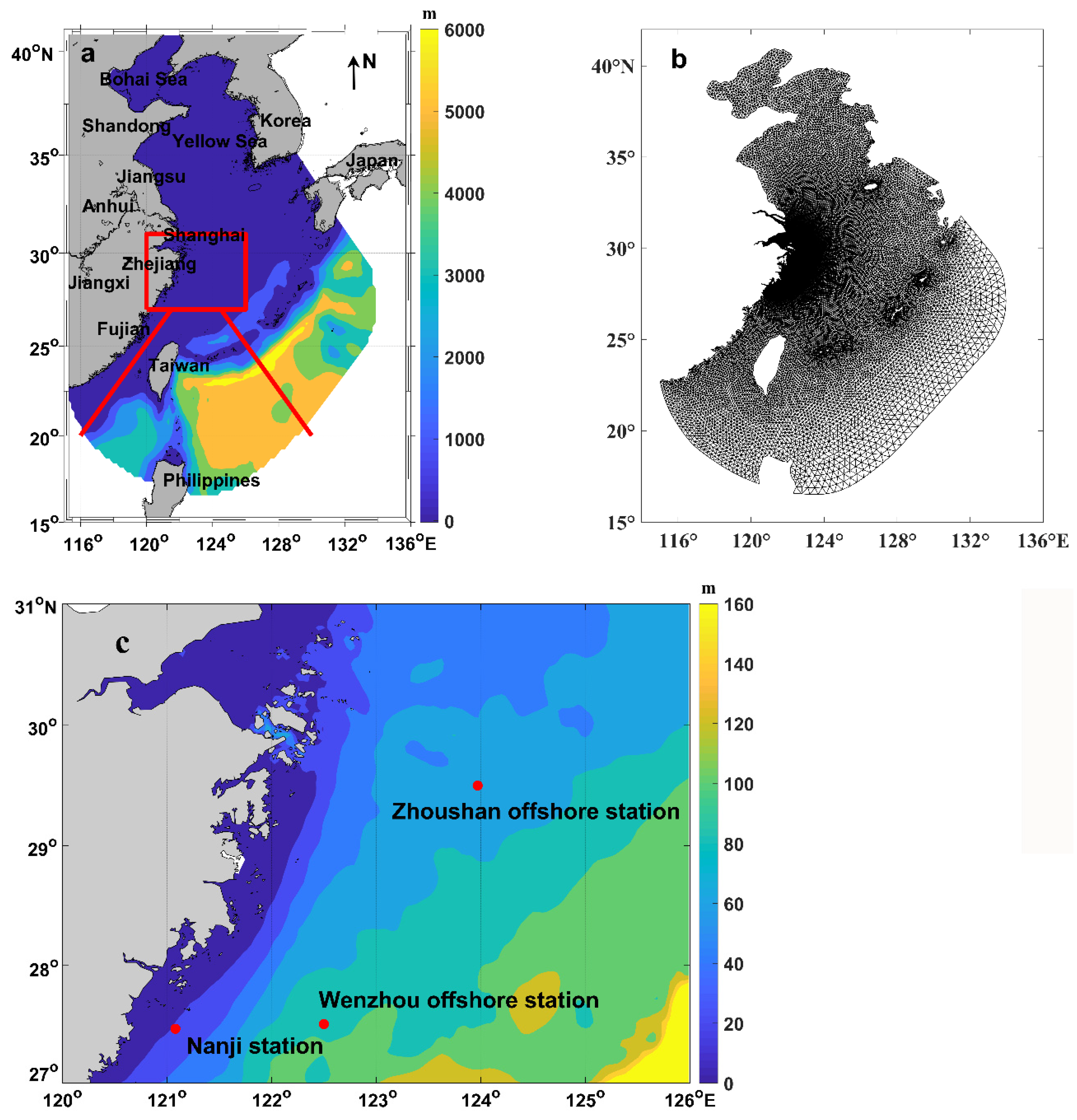
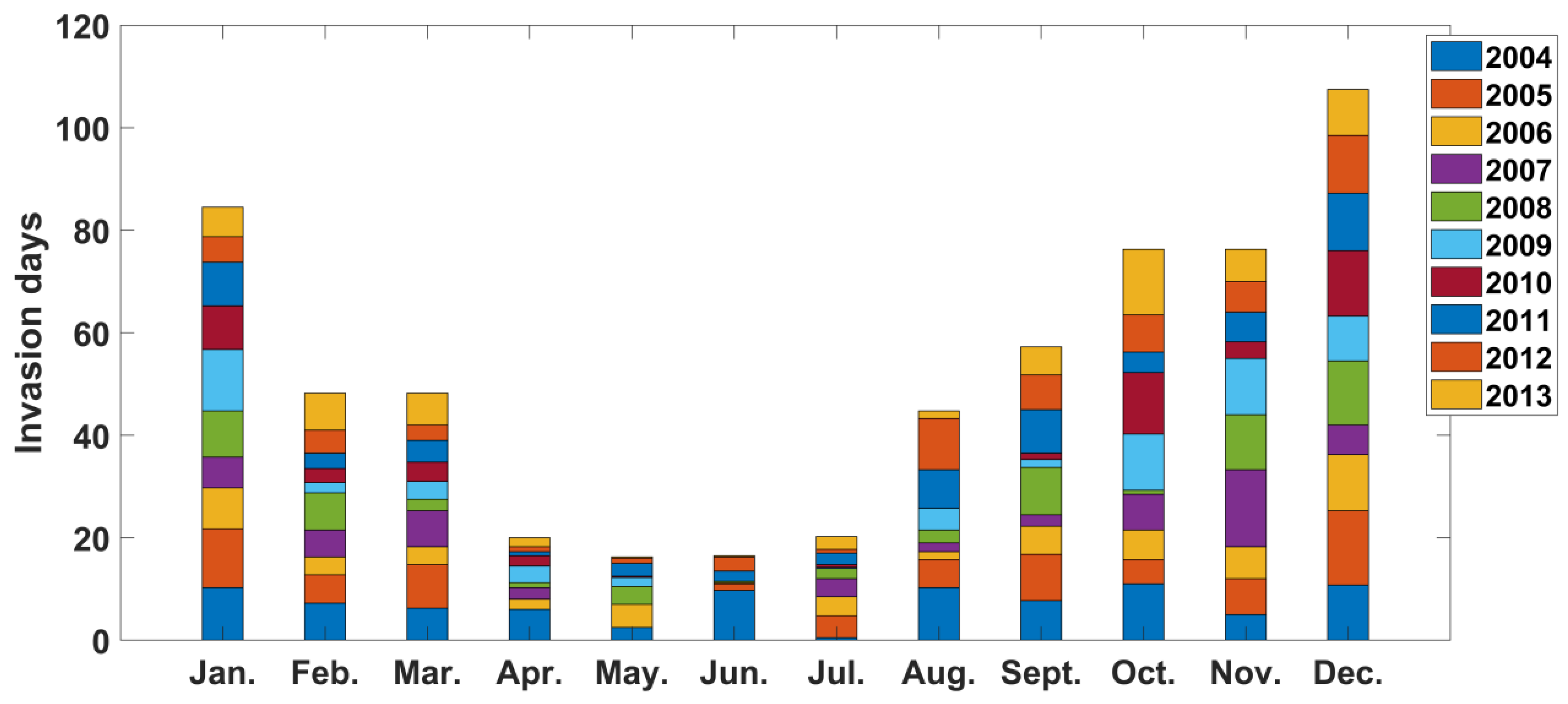

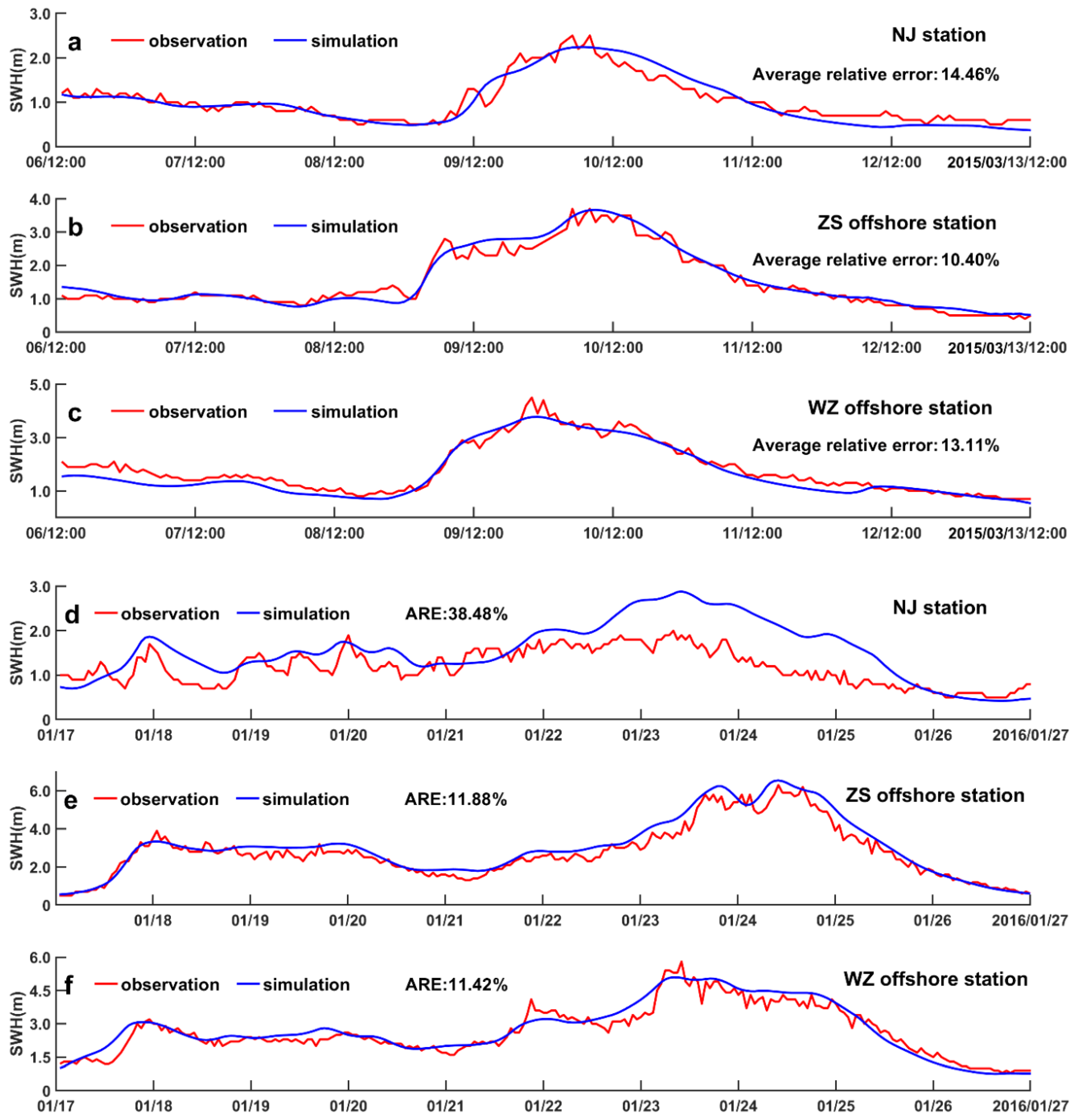


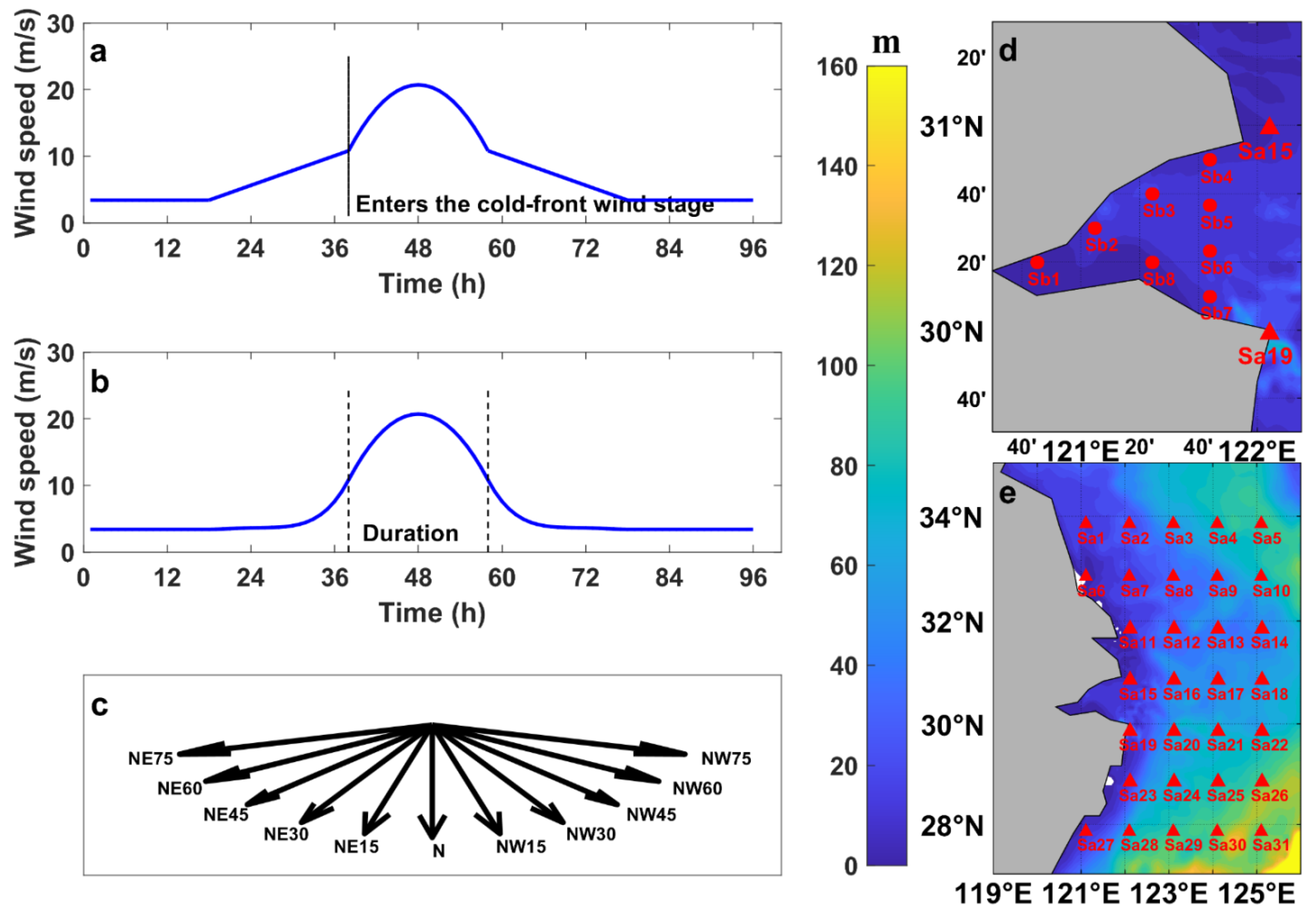
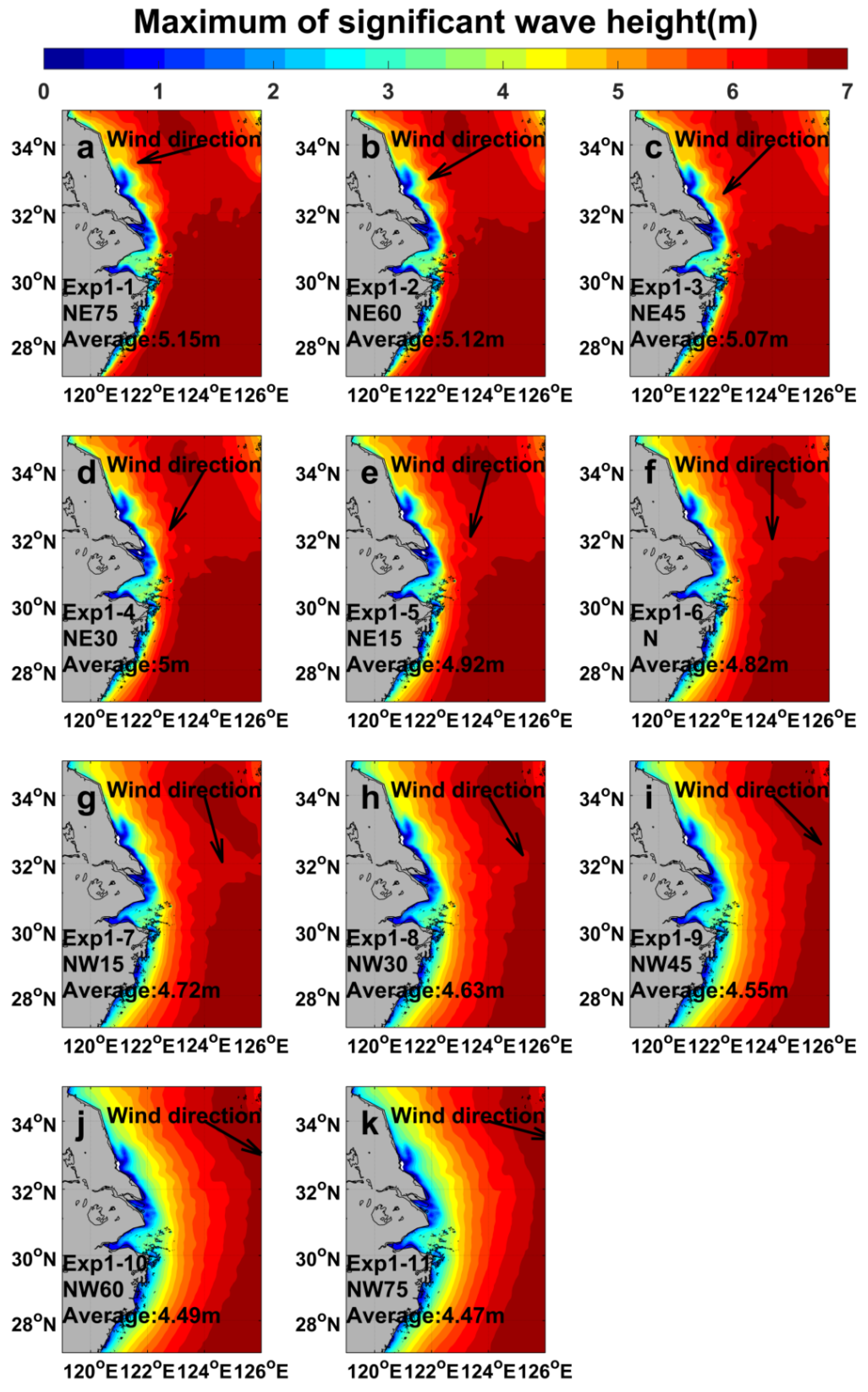
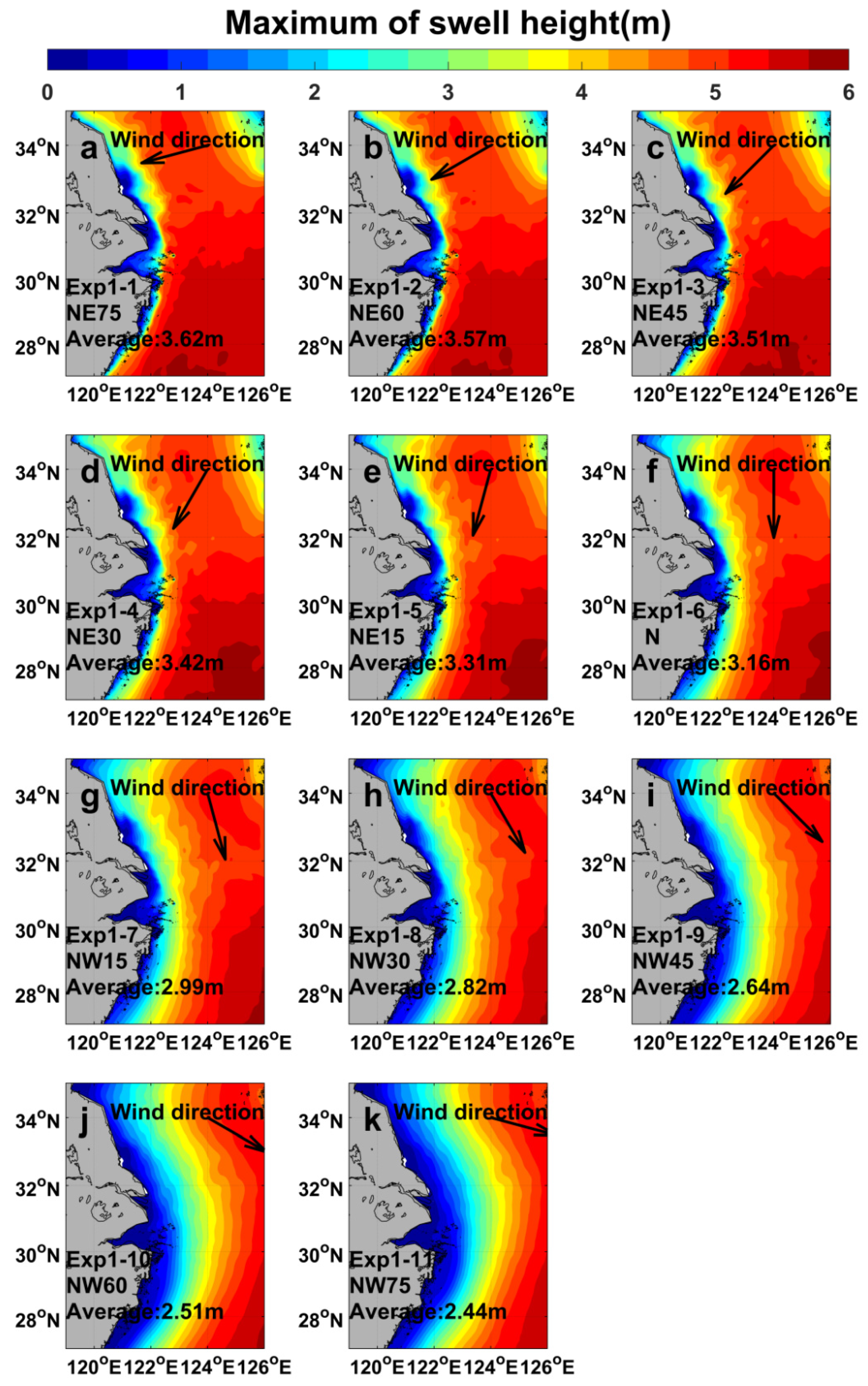
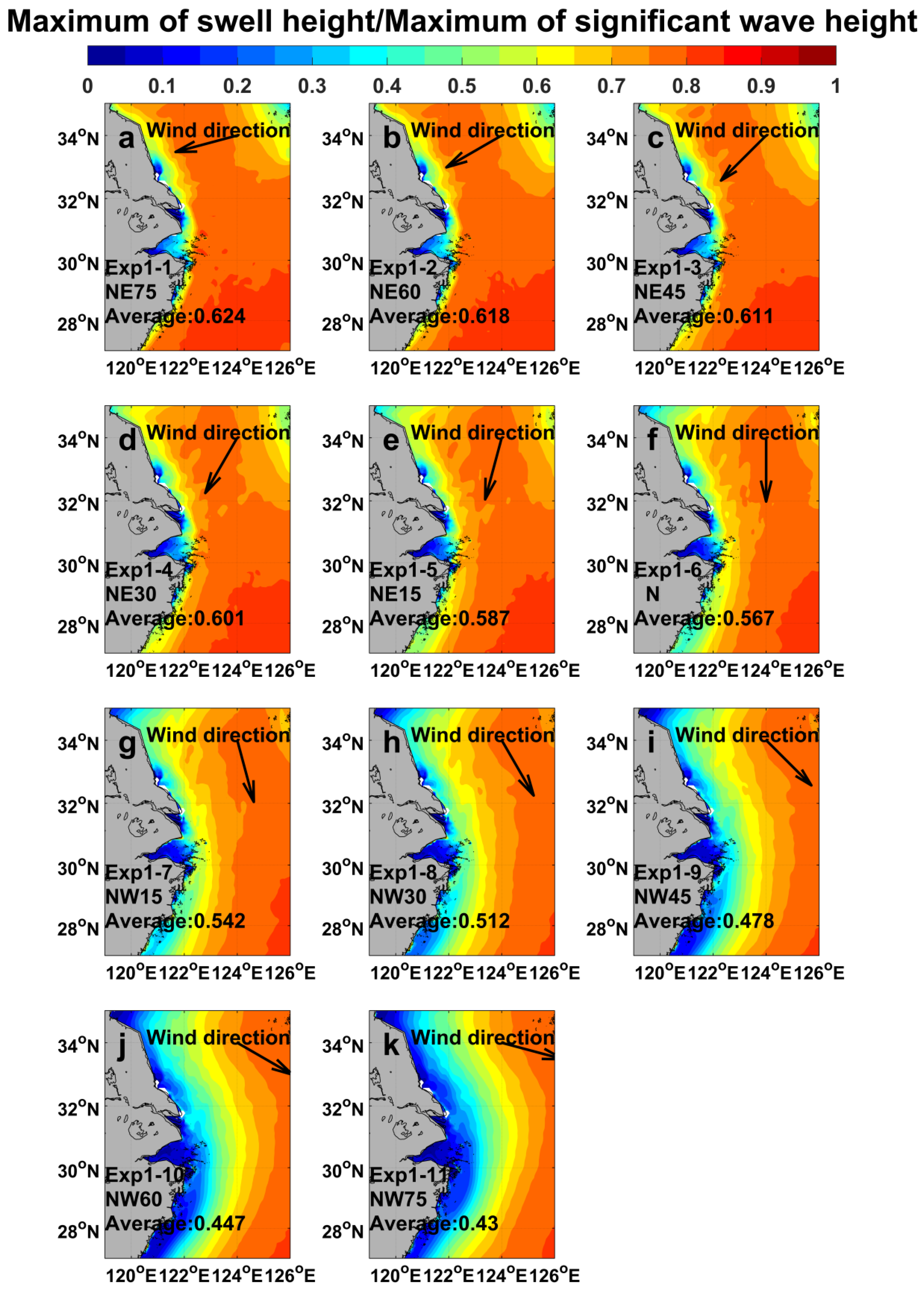
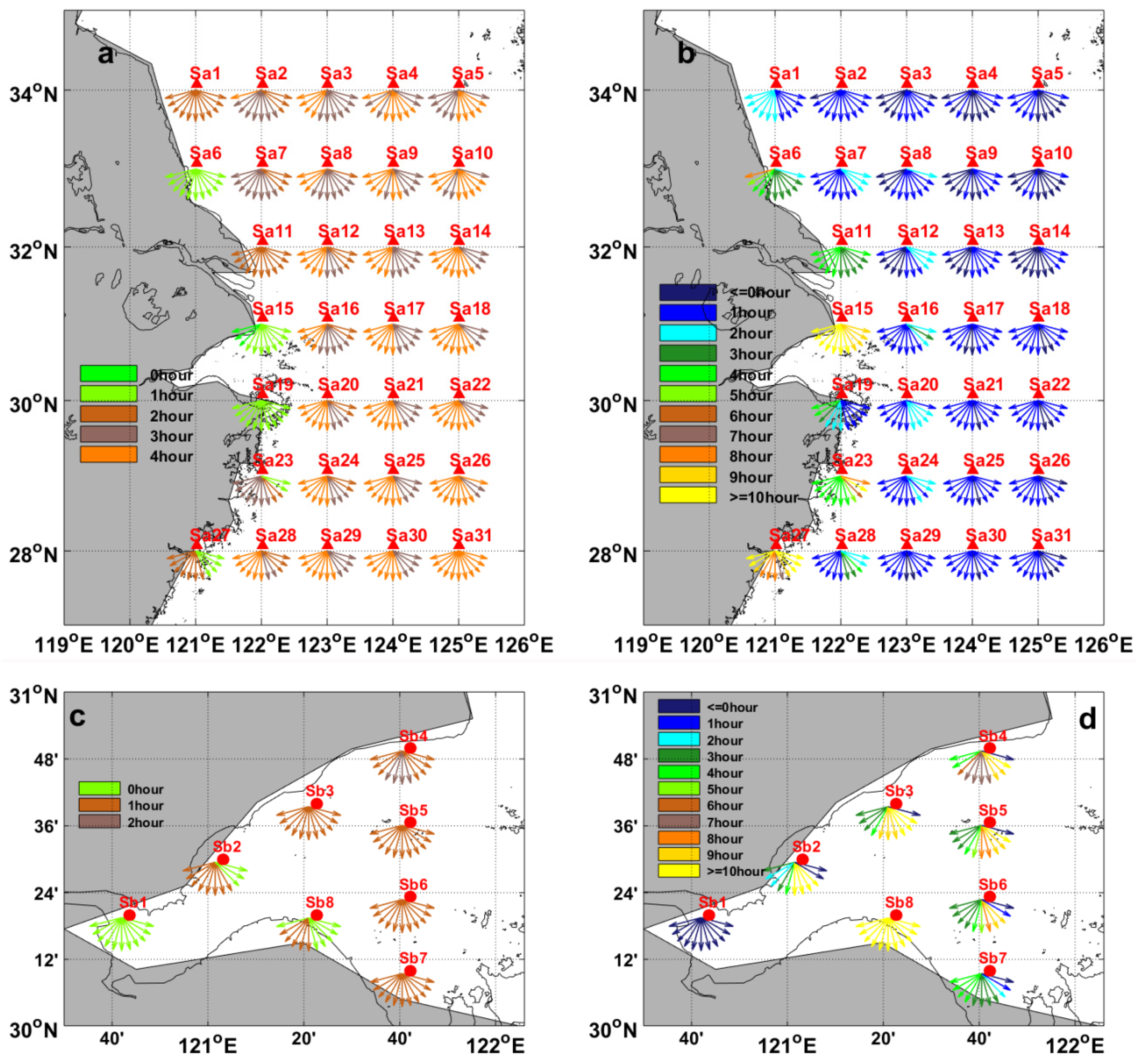
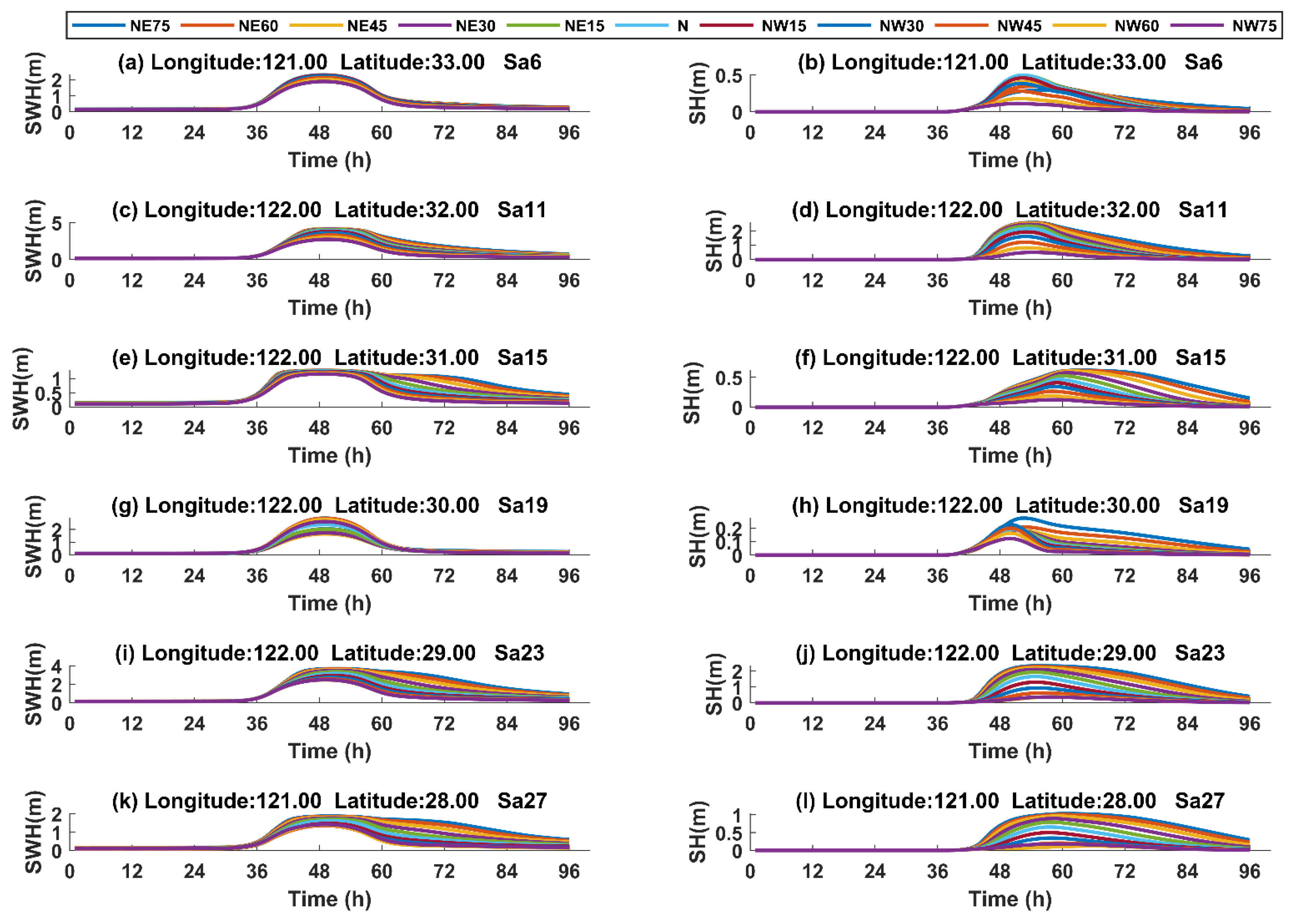
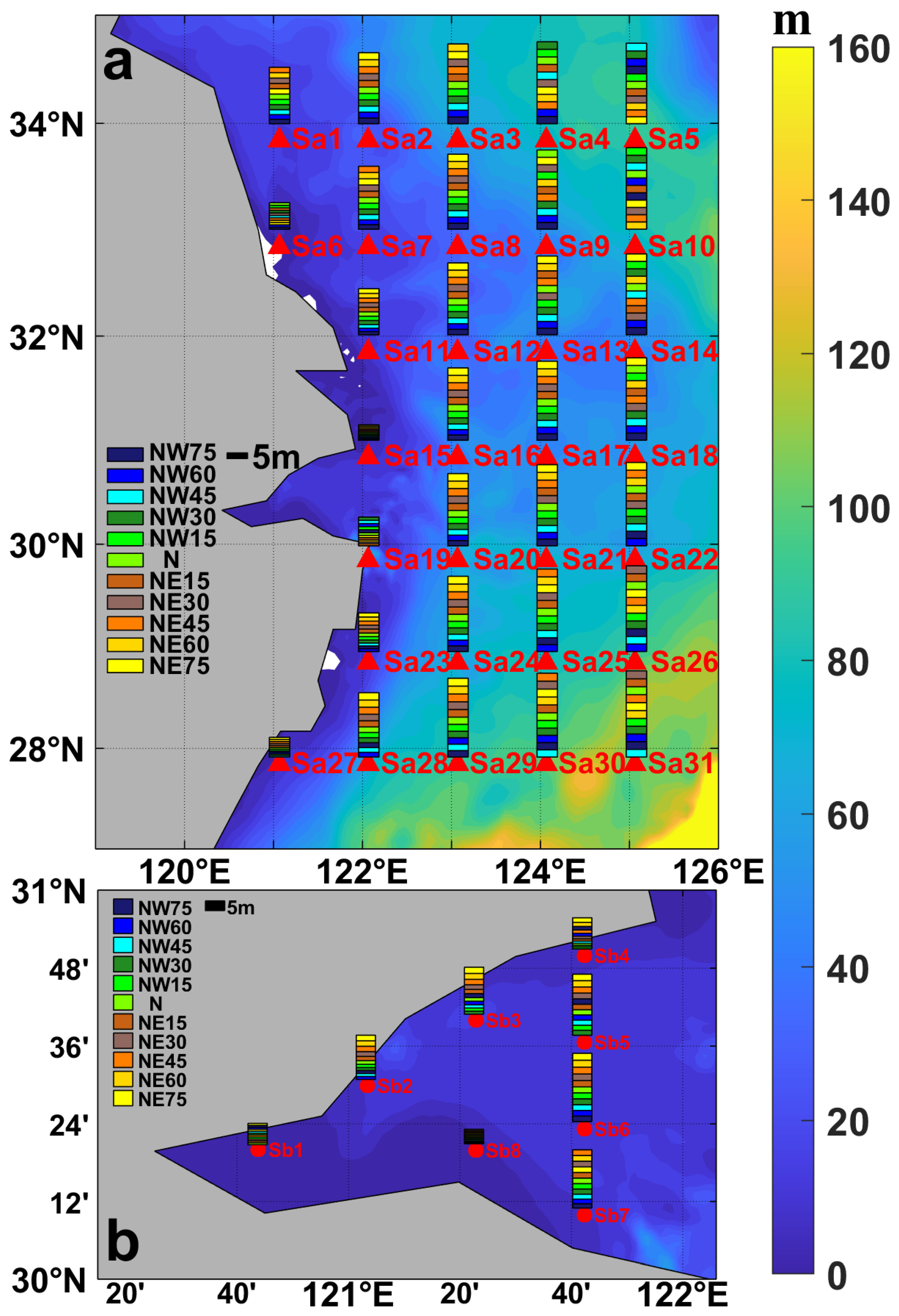
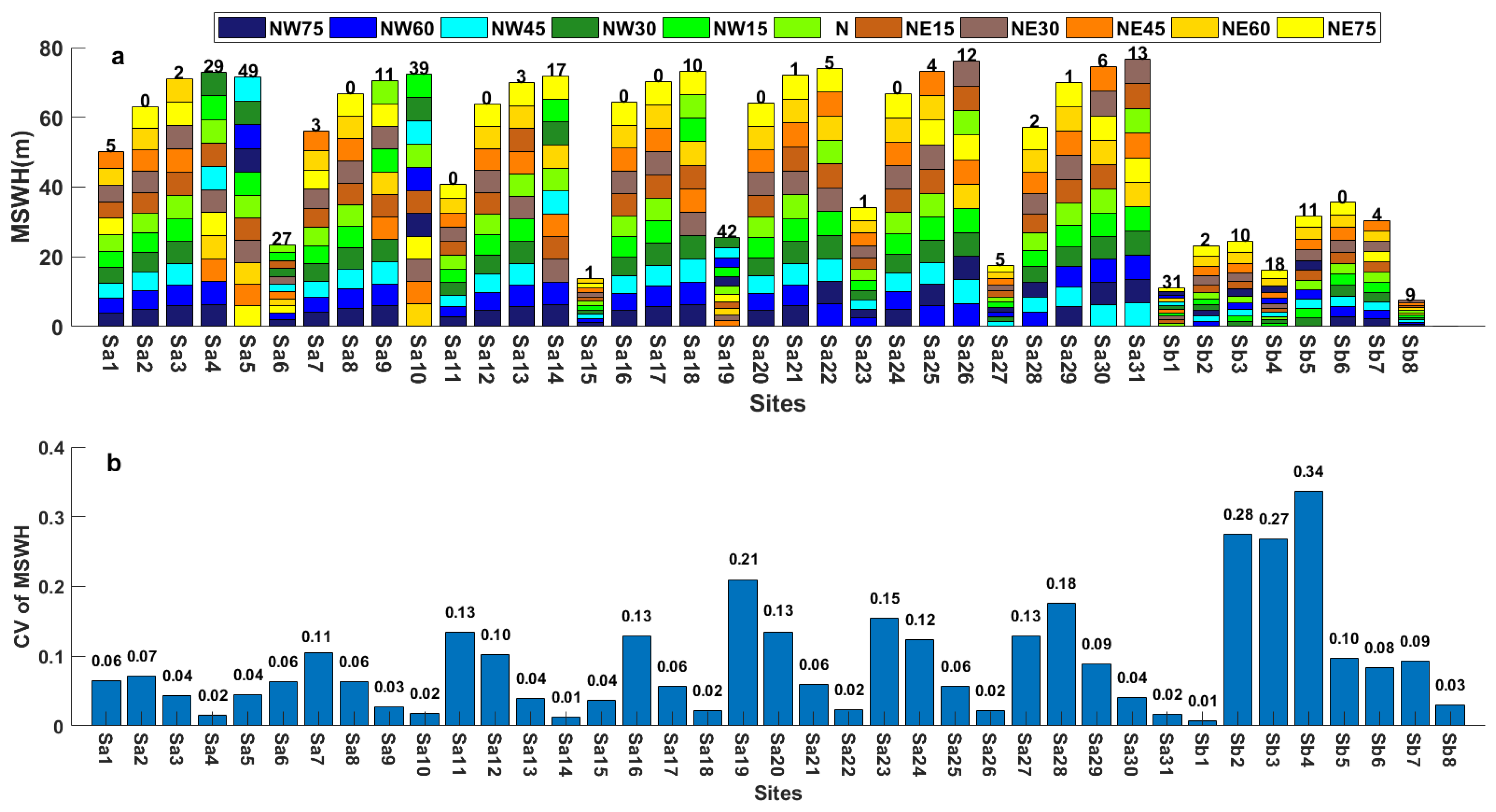
| Station | Longitude | Latitude | Water Depth (m) |
|---|---|---|---|
| NJ | 121.08° E | 27.46° N | 21.26 |
| WZ | 122.50° E | 27.50° N | 91.44 |
| ZS | 123.97° E | 29.50° N | 69.44 |
| No. | Direction | Average MSWH (m) | Average MSH (m) | Average MSH/MSWH |
|---|---|---|---|---|
| Exp1-1 | NE75 | 5.15 | 3.62 | 0.624 |
| Exp1-2 | NE60 | 5.12 | 3.57 | 0.618 |
| Exp1-3 | NE45 | 5.07 | 3.51 | 0.611 |
| Exp1-4 | NE30 | 5.00 | 3.42 | 0.601 |
| Exp1-5 | NE15 | 4.92 | 3.31 | 0.587 |
| Exp1-6 | N | 4.82 | 3.16 | 0.567 |
| Exp1-7 | NW15 | 4.72 | 2.99 | 0.542 |
| Exp1-8 | NW30 | 4.63 | 2.82 | 0.512 |
| Exp1-9 | NW45 | 4.55 | 2.64 | 0.478 |
| Exp1-10 | NW60 | 4.49 | 2.51 | 0.447 |
| Exp1-11 | NW75 | 4.47 | 2.44 | 0.430 |
Publisher’s Note: MDPI stays neutral with regard to jurisdictional claims in published maps and institutional affiliations. |
© 2021 by the authors. Licensee MDPI, Basel, Switzerland. This article is an open access article distributed under the terms and conditions of the Creative Commons Attribution (CC BY) license (https://creativecommons.org/licenses/by/4.0/).
Share and Cite
Xu, P.; Du, Y.; Zheng, Q.; Che, Z.; Zhang, J. Numerical Study on Spatio-Temporal Distribution of Cold Front-Induced Waves along the Southeastern Coast of China. J. Mar. Sci. Eng. 2021, 9, 1452. https://doi.org/10.3390/jmse9121452
Xu P, Du Y, Zheng Q, Che Z, Zhang J. Numerical Study on Spatio-Temporal Distribution of Cold Front-Induced Waves along the Southeastern Coast of China. Journal of Marine Science and Engineering. 2021; 9(12):1452. https://doi.org/10.3390/jmse9121452
Chicago/Turabian StyleXu, Pinyan, Yunfei Du, Qiao Zheng, Zhumei Che, and Jicai Zhang. 2021. "Numerical Study on Spatio-Temporal Distribution of Cold Front-Induced Waves along the Southeastern Coast of China" Journal of Marine Science and Engineering 9, no. 12: 1452. https://doi.org/10.3390/jmse9121452
APA StyleXu, P., Du, Y., Zheng, Q., Che, Z., & Zhang, J. (2021). Numerical Study on Spatio-Temporal Distribution of Cold Front-Induced Waves along the Southeastern Coast of China. Journal of Marine Science and Engineering, 9(12), 1452. https://doi.org/10.3390/jmse9121452






